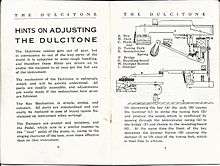Dulcitone
A dulcitone is a keyboard instrument in which sound is produced by a range of tuning forks, which vibrate when struck by felt-covered hammers activated by the keyboard. The instrument was designed by Thomas Machell of Glasgow in the 1860s, at the same time as Victor Mustel's organologically synonymous typophone,[1] and manufactured by the firm of Thomas Machell & Sons during the late nineteenth and early twentieth centuries.
Most of the early models are tuned to sharp pitch, or the diapason normal of a 435. Some of the late models use an action suspended on a system of leaf springs, which is considerably quieter than that illustrated.
Description

The dulcitone is a transposing instrument of the idiophone class; it sounds an octave higher than the standard (eight foot pitch) written pitch. It has a five octave written range from AA to a3 (sounding range from A to a4).
A significant feature of the dulcitone was its portability, a product of its lightweight and compact construction and the fact that the tuning forks (unlike, for instance, the strings of a piano) were not prone to going out of tune. However, the volume produced is extremely limited, and the dulcitone's part is frequently substituted by a glockenspiel.[2]
Two pieces scored for the dulcitone is Vincent d'Indy's Song of the Bells (1888) and Percy Grainger's "The Power of Rome and the Christian Heart" (1943).
In 1911 there were 3 versions listed: Style B, with 3½ octaves in solid mahogany (polished Chippendale) or in solid oak (fumed) complete with folding stand, for £12; Style R - in mahogany or oak with 4 octaves for £15; Style F - in mahogany or oak with 5 octaves, for £18.
Surviving examples exist as far afield as New Zealand, where one is preserved in the Whittaker's Musical Museum.
See also
- Rhodes piano, technically an electrically amplified dulcitone.
- Celesta, similar to the dulcitone in that bars are struck by hammers.
Gallery
- Overall view of Dulcitone
- View of Dulcitone keyboard
- Name decal on inside of lid
 Front cover of users manual
Front cover of users manual Page 2 & 3 of users manual
Page 2 & 3 of users manual
References
- Mo, Sue. "Dulcitone". Sumo55 Websites & Multi Media Design. Retrieved 28 September 2016.
- The Ultimate Encyclopedia of Musical Instruments, ISBN 1-85868-185-5